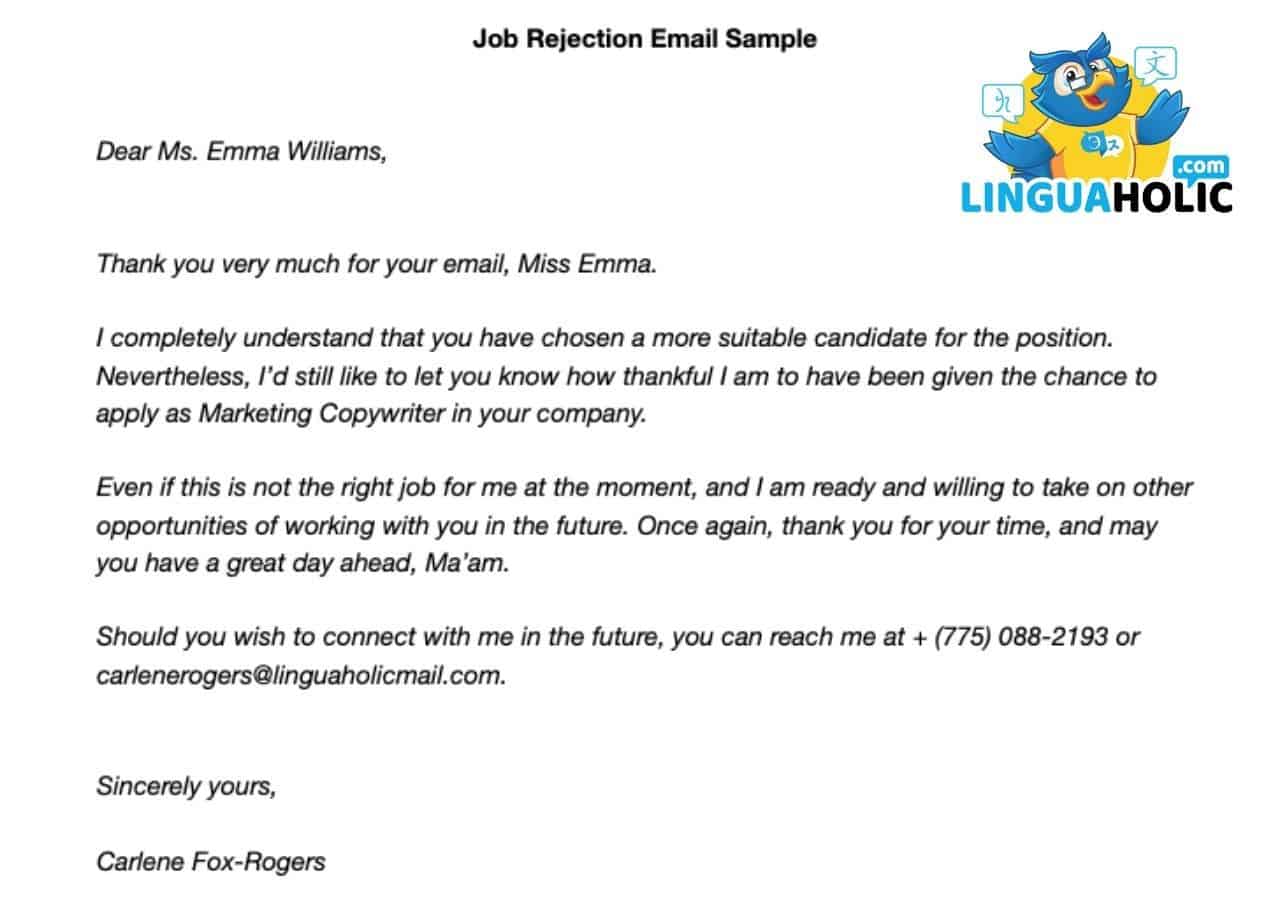A job rejection could give us one of the most obnoxious feelings in this world because it may stimulate the impression that we may not be good enough for a certain role.
But, expectedly enough, most, if not all, people have experienced some form and degree of rejection at least once in their lifetime.
That said, today’s inquiry is quite simple to address in terms of written language use because there are recurring patterns that we can conveniently refer to and follow.
Without further ado, let’s begin with a quick answer.
How can we respond to a job rejection email?
- Write a formal salutation or greeting
- Thank the sender for the email
- Show understanding toward the decision
- Express post-rejection gratitude
- Offer oneself for future opportunities
- End the email with a positive note
- Provide contact details
- Write a closing remark and signature
Responding to a job rejection email: Detailed steps
Given the fact that job rejections can be intolerable at times, it may not be that easy to deal with such form of challenges in actual situations.
Although we can always search for tons of pieces of advice online, having to deal with rejections can either strengthen or weaken our self-esteem.
Apparently, it is always recommended to go with the healthier option as much as we can; moreover, following detailed guidelines on specific language usage will also make a difference.
Listed below are the detailed steps for responding to a job rejection email, as well as several example scripts to guide you on your quest on finding your ideal job.
Write an appropriate and formal salutation or greeting
In formal correspondence such as in responding to a job rejection email, it is always recommended to follow a standard structure or format.
This means that we must start by choosing the most appropriate salutation or greeting expression to match the formality level of this kind of correspondence.
With that being said, it would be inappropriate to use “To Whom It May Concern:” in this context; using “To Whom It May Concern:” in recommendation letters instead may be acceptable.
Formal correspondence entails the observance of proper punctuation; this conveys communicative competence and attention to detail — skills that every employer is likely looking for.
If you wish to completely understand how to punctuate salutations, you may also refer to our text titled “Comma After Salutations like ‘Hi,’ ‘Hello,’ or ‘Dear’” for a more definitive discussion.
Below, you may select any of the following formal salutations to start your email:
Examples:
Thank the email sender for sending you an email
An act of gratitude communicates politeness as well as other positive values. Hence, starting off your email message with a thank-you statement is not only appropriate but also highly advised.
Here, you can focus on thanking the email sender for sending the information to you. If the person reaches out to you promptly, recognize the act by specifically mentioning this detail.
And by extension, actively call out the name of the person in your gratitude message to start off with some degree of personalization which could equate to sincerity.
Here are some examples for your reference:
Examples:
Show that you understand the decision of the employer
Since you are writing a response to a job rejection decision, it is meanwhile essential to demonstrate to the employer that you thoroughly understand their intention for communicating with you.
This part specifically affirms the email sender that the content of the message sent to you is not ambiguous nor misleading.
Here, you can simply state that you have completely understood the content of the email you received.
Alternatively, you may also reiterate the statement that contains the rejection decision of the employer to be extra clear with what you want to convey.
Feel free to choose any of the following statements in your email response:
Examples:
Express post-rejection gratitude to the recruiter or employer
The written language lacks the other crucial elements of effective communication such as facial expressions, body gestures, and voice tonality.
Therefore, it is important to communicate your thoughts as thoroughly and formally as possible to fill the mentioned gaps.
More importantly than telling the sender that you understand what the email means, you must also convey that you appreciate the chance given to you by the employer to show your worth.
Apparently enough, it is unprofessional, even immature, to hold grudges towards the employer or the recruiter for choosing another person over you.
Explicitly expressing post-rejection gratitude highly likely communicates how well you can deal with real-life challenges, which then further exemplifies your overall value as a person.
You may refer to the following statements as to how to represent this idea:
Examples:
Put yourself forward for future career opportunities
Everything discussed earlier only serves as pre-warming strategies in responding to a job rejection email; the most indispensable part is explained in this section.
When we get rejected in a job application, it is extremely paramount that we keep seeking other career avenues so as to extend our existing network.
That said, we must actively offer ourselves to the rejecting employer to prompt this event. Of course, we must note that there is an underlying message behind the surface meaning of the examples below:
Examples:
Remember that the recruiting team of the human resource department is responsible for the continued sourcing of applicants for job openings.
Moreover, they are also connected with other people belonging to the same industry. So, explicitly demonstrating your willingness to accept other career opportunities will likely prompt a recommendation in the least.
End the email message with a positive note to lighten up the situation
It is important to know how to end emails professionally, as it summarizes how competent you are, not only as an applicant but as a person, too.
The second to the last of your email message entails the inclusion of a positive remark to further lighten up the entirety of the situation.
Here, you can address the email sender directly by stating his or her name or name title in the least. This technique, once again, helps in sounding more personal and sincere.
Here are some example statements that you can use:
Examples:
Provide active contact details for future correspondence
Last but not least, you must not fail to provide your most active pieces of contact information so prospective employers can reach out to you directly in the future.
Listing these details, in particular, means indicating your active personal mobile number, as well as your personal email address.
Do not use your work email address or mobile number so as to ensure that future messages would go directly to your own inbox.
Here are possible ways of doing so:
Examples:
Conclude with a suitable valediction remark together with a signature
Since you’ve started with a formal greeting, it is also best to mark the end of your email content with a valediction or closing remark together with your complete name or signature.
Doing so communicates tact and attention to detail — two of the most highly significant traits that employers would look for.
Despite the formulaic and sometimes unexciting connotation of valediction remarks, you must always use one in any formal correspondence.
Here are some suggestions:
Examples:
Kindest regards,
Christopher Jenkins
Sincerely yours,
George Rivers
Warmest regards,
Celine Atkinson
If you’d like to learn more about the valediction remark “Warmest regards,” feel free to refer to our additional resource that discusses the meaning and usage of “Warmest regards” in correspondence.
The other things to bear in mind when responding to a job rejection via email
Apart from being done via emails, job rejections may also happen orally or through a direct phone call from the employer to the failed applicant.
Hence, it is ideal to know how to deal with a job rejection call to manage the discomfort effectively; you could even turn things around if you deal with the rejection confidently enough.
Use the formal language register
Formal language use specifically fills the gap entailed by the absence of facial expressions, body language, and tone of the speaker’s voice.
So, always stick to the formal register as a default rule in business and even academic kinds of correspondence especially if you’re doing it via email.
As an exception, you may reduce the formality degree of your language if you are communicating via direct messaging platforms like Linkedin messenger, for instance.
The formal language register is also advised if and when you have a psychologically distant relationship with the other person, such as an employer, professor, or prospective client.
Keep your message simple yet sincere
Writing an extremely short email response to a job rejection email might be misinterpreted as a sign of unprofessionalism.
Meanwhile, writing a thesis-long job rejection response may also come across as a sign of pretentiousness or grandiosity.
Therefore, it is always best to keep your email message at an adequate length to address these end-of-the-spectrum correspondence issues.
Do not let a single rejection or even a series of it let you down
Most importantly, you must never, ever, let job rejections bring you to the end of your wits because you can always find better opportunities elsewhere.
A single rejection, or even a series of it, does not mean that you are not competent enough; oftentimes, it means that you are just looking for a job opportunity in the wrong space.
So, you must not easily give up on your goal of landing a decent and lucrative job role because experience, as cliche as it may seem, is always the best teacher.
How to respond to a job rejection email: Full sample text

Frequently Asked Question on “How to Respond to a Job Rejection Email”
Should we reply to a job rejection email?
Yes, we should reply to a job rejection email to confirm that we have successfully received and completely understood the content of the email. Doing so communicates politeness to the email sender or employer.
How do you politely accept a job rejection?
Politely accepting a job rejection entails explicitly thanking the employer for the email sent to you, as well as expressing gratitude for the opportunity given to you by the employer to share your relevant skills and qualifications.
How can we respond graciously to a job rejection?
To respond graciously to a job rejection email or phone call, we must use the formal language register and avoid casual, ambiguous language use. Also, the email message must specifically contain gratitude statements addressed to the employer to convey pleasantry and politeness.
Conclusion
Like any other form of communicative event, using clear, unambiguous language is a standard rule in business correspondence.
This enables us, humans, to maintain healthy exchanges of information, which is a fundamental building block of our society.

Hey fellow Linguaholics! It’s me, Marcel. I am the proud owner of linguaholic.com. Languages have always been my passion and I have studied Linguistics, Computational Linguistics and Sinology at the University of Zurich. It is my utmost pleasure to share with all of you guys what I know about languages and linguistics in general.

